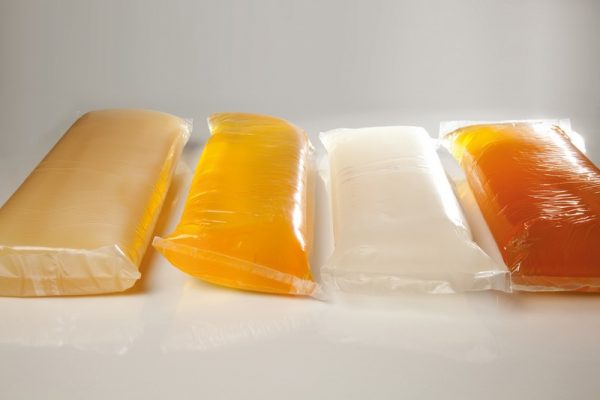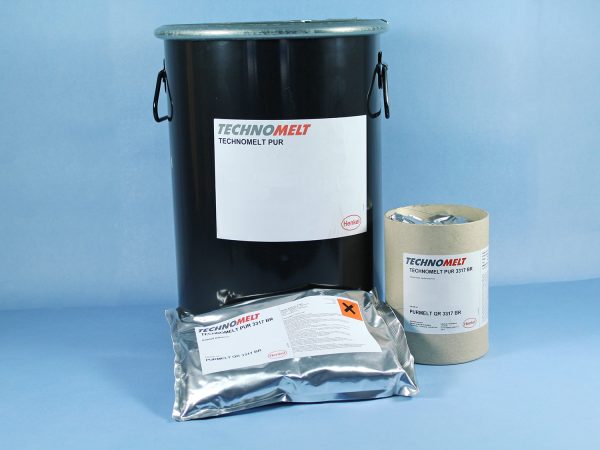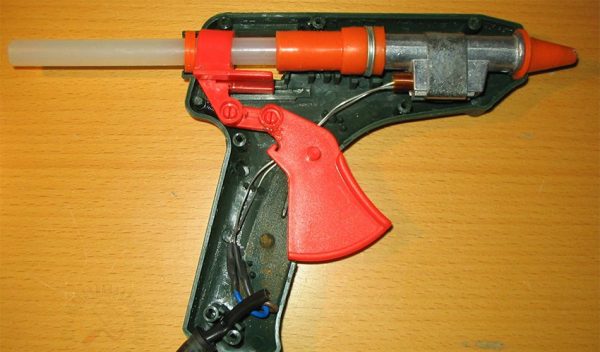For household needs, glue is often required - it is with the help of it that you can repair shoes, metal, plastic, leather and glass products. Glue is also widely used for needlework, making crafts from fabric, paper. In some cases, only hot-melt adhesive, which adheres so firmly to the surface, will help to reliably connect parts that it will be impossible to tear off the product by hand. Unlike water-based cold welds, such products contain complex polymers.
- The main advantages and features of hot-melt adhesive
- Glue varieties
- In composition
- Ethylene Vinyl Acetate (EVA) Adhesives
- Polyamide (PA) Adhesives
- Polyolefin Adhesives
- Polyester Adhesives
- Synthetic Adhesive Rubber
- Amorphous polyalphaolefin (APAO) in the manufacture of adhesives
- Reactive Polyurethane (PUR) as a base for adhesives
- By color
- By diameter and length of glue sticks
- Hot glue gun: design and features
- Distinctive features of hot glue guns
- Necessary glue heating temperature
- Glue feed rate
- Methods for applying glue
- Hot Glue Safety
- Hot Glue Crafts
- Removing glue from clothes

The main advantages and features of hot-melt adhesive
Hot melt is understood to mean the adhesive composition, which, upon reaching the melting temperature (100-200 degrees), becomes liquid, then, when cooled, it goes into a solid state, and such “metamorphoses” can be repeated. In the furniture industry, hot glue has long been known and is called hot melt glue. It is in liquid form that the material has the unique property of penetrating the smallest cracks, dents, and has the highest adhesion. When the glue becomes hard, the formed seam will be incredibly strong.
Hot-glue composition is available in a special form - in the rods. It looks like this because use is possible with a thermal gun. The latter has a channel for the insertion of such a rod and is designed specifically for heating and applying funds. Hot melt adhesive has several advantages:
- Heavy duty bonding. The material glues parts better than many formulations and has the highest tensile strength. To peel off the product, you must apply a force of not less than 150 kg. By strength, fixing with hot glue is similar to metal fasteners.
- Quick drying. Glue polymerizes in a few minutes, and at a certain temperature - in seconds. This characteristic of the product is ideal when working with small parts, although when assembling large-sized products it will be necessary to show dexterity.
- Long operation. The glue does not respond to aggressive factors - cold temperatures, water, ultraviolet radiation, household chemicals. Thanks to these properties, the glue line will last for many years.
- Reasonable price. Hot-melt adhesive is sold everywhere, it is inexpensive, and it can have a different length of the rod (you can choose a tool even for the smallest part and not overpay).
- No traces when removing glue. If you want to remove the glue line, after it is heated and cleaned, there will be no ugly spots, the product will not be damaged.
- Work as a sealant. Using hot melt adhesive, you can firmly seal the grooves, cracks.
- Security.The glue melts without releasing harmful components, so it can be used even for children's creativity.
The disadvantages include the low plasticity of the product. The glue forms a rigid joint that does not shrink. Therefore, you can not always use it. If construction, decoration materials, household products have a large coefficient of thermal expansion, the connection may be broken. True, this is not about all types of glue. Now there are modern polymers that are elastic in structure and perfectly tolerate vibration, other mechanical influences.
to contents ↑There is no restriction with respect to hot-melt adhesive if heterogeneous materials are to be bonded. It is suitable for plastic and wood, can even bond metal to ceramics, if required.
Glue varieties
Depending on the characteristics (composition, color, size and other features), there are various types of hot melt adhesive.
In composition
All adhesives have a similar composition. The basis (up to 50% by weight) are thermoplastic polymers, the rest is distributed between resins and plasticizers. This type of glue does not contain harmful organic solvents. Most often, products based on ethylene vinyl acetate, polyamide can be found on sale, although there are other types of materials.
Ethylene Vinyl Acetate (EVA) Adhesives
EVA hot melt adhesives have the most favorable price-quality ratio, therefore they are the most popular. They are available in the form of rods for a pistol, any household products can be glued, used in repairs, at a construction site. For industry, ethylene vinyl acetate adhesives are most often supplied in pellets for automatic use. In the furniture industry, such tools are used for gluing edges, profiles, veneers. With their help, spring blocks are made for mattresses, car filters.
to contents ↑Polyamide (PA) Adhesives
Such tools are usually used for bonding materials that are subject to special requirements. This is due to the resistance of polyamide compounds to the action of high temperatures, temperature extremes (-35 ... + 135 degrees). Polyamide adhesives do not deteriorate from the action of water, mineral and vegetable oils, lubricants. Does such a hot glue conduct current? Due to the low electrical conductivity, the material is widely used for the repair of electrical engineering and LEDs, the production of insulation for electrical wires.
to contents ↑Polyolefin Adhesives
Such agents have even higher adhesion rates. Such adhesives are economical in consumption, have the highest flexibility among all types of hot melt adhesives. Due to the excellent adhesion, the agents can be applied by the linear point method or by spraying. Such adhesives are used in the manufacture of plastic packaging, because they provide the highest performance.
to contents ↑Polyester Adhesives
If the hotmelt adhesive contains polyester resins, this means you can reliably glue fiberglass products, attach metal to glass, foil to cork, and even asbestos to copper, another metal, alloy. Powerful adhesion comes from the presence of hydroxyl and carboxyl groups in the polyester molecule. Most often, polyesters of maleic acid, polyethylene glycols, as well as various comonomers (vinyl acetate, styrene) are used to create adhesives. Glues withstand up to 40 freezing cycles, the effect of atmospheric factors for 5 years.
to contents ↑Synthetic Adhesive Rubber
Residual adhesives contain artificial rubber. After drying, they retain some stickiness, but the heat resistance of the products is very high, as well as elasticity, moisture resistance. Typically, rubber adhesives are used to fasten the roots of books and magazines, they also glued probes, attached plastic cards. This type of material is suitable for impregnation of non-woven materials, insulation of wires.
to contents ↑Amorphous polyalphaolefin (APAO) in the manufacture of adhesives
Such a composition includes a solid thermoplastic polyolefin, at least one polyester (usually based on urethane, polycaprolactone), one amide. This type of adhesives is characterized by good adhesion to any surfaces except Teflon - this material can not be held by the adhesive composition. The tool is used in the automotive industry (for example, for headlights, filters), the furniture industry and in creating interior decoration.
to contents ↑Reactive Polyurethane (PUR) as a base for adhesives
Hot melt adhesives on polyurethane after polymerization form a high-strength, flexible film that does not deteriorate at high and low temperatures. The difference from other types of hot-melt adhesives consists in long hardening - it lasts 1-2 days and depends on humidity, thickness of the adhesive layer. The unique ability of reactive polyurethane is the possibility of further processing of the seam after drying. The most durable in the line of such adhesives are POR adhesives, which are excellent for polypropylene, polyethylene, vulcanization of rubber.
to contents ↑By color
Depending on the color, the adhesive compositions may also vary. Each of them has its purpose:
- translucent white glues are universal means that allow you to both glue any objects and make crafts yourself (for example, snowflakes);
- opaque white adhesives - used to bond white parts, well suited for glass;
- transparent yellow adhesives - usually used for paper, cardboard, have universal properties;
- colored opaque adhesives - used for bonding colored products in order to create an invisible seam;
- black, gray adhesives are sealants, due to the safety of the composition they can be used in an aquarium, they are also suitable for insulating wires.
By diameter and length of glue sticks
The diameter of the glue core is most often equal to 7 or 11 mm. There are also non-standard solutions - a little more or less than the specified size, but when buying it is necessary to take into account the diameter of the existing glue gun. The length of the glue sticks is usually 4-20 cm, they should be selected depending on the need, the size of the surfaces to be glued.
Hot glue gun: design and features
The shape of the glue gun is similar to a regular gun, therefore it got its name. The device is seasoned with a glue stick, which when heated melts to a fluid consistency. You need to install the rod from the back of the tool, tucking it into a special receiver. Its tip falls into the heating module during operation, and in about 4-5 minutes the glue melts. When you pull the trigger, the composition leaves the nozzle on the surface of the product.
The design of the glue gun includes the following elements:
- Heating module. Located in the trunk, it is a metal reservoir, from the bottom of which there is a heating unit. More expensive models have several heating units for melting glue.
- Ring pusher. This is the glue supply mechanism, which most often breaks down, mainly with excessive user effort.
- Coupling. In appearance, this is a tubular receiver located under the glue heating chamber. The clutch is needed to seal the system elements so that the molten composition does not get into them.
- Nozzle (nozzle, nozzle). Allows you to direct the flow of glue in the right direction. Inside there is a shut-off valve that prevents the free flow of the solution. Outside, the nozzle is coated with a heat-resistant alloy that protects it from damage. This part of the gun must be regularly cleaned of glue residue.
Distinctive features of hot glue guns
When choosing, you need to pay attention to the quality of the body of the heat gun for glue. The box itself should be made of durable polymers that can withstand heat without burning your hand. There are models with a viewing window where you can see the rest of the glue. Anti-slip inserts are often made on the handles, and a stand is included in the package. Interesting is the design of the spray gun, which greatly accelerates the application of glue on large surfaces. When buying a gun, it is necessary to compare the diameter of its barrel with the size of the core made of glue - they must match.
to contents ↑Necessary glue heating temperature
The glue begins to melt already at +80 degrees, but the process will be very slow. Therefore, the guns make it possible to melt the material at + 150 ... + 200 degrees, which seriously increases productivity. In expensive professional models, the heating temperature of the glue reaches +500 degrees.
Glue feed rate
Usually glue guns can deliver 5-20 g of glue per minute, although the speed depends on the heating time and the needs of the user. The upper limit of the indicator, in fact, is the limit of the capabilities of both the device and the master, otherwise there is a great risk of error. Nevertheless, special high-speed pistols are sold to professionals (30 g of glue per minute and higher).
to contents ↑
Methods for applying glue
The easiest and most inexpensive ways to perform work with glue - manual application, spreading the mass with a small roller with preliminary heating. Nevertheless, it is much more convenient to use a glue gun, especially if you need to attach not too small parts. The glue stick in the gun warms up, after which the composition will be ready for use.
Bonding is carried out in this way:
- clean the parts from dirt, dust, completely degrease the working surface (fats can be dissolved with acetone, alcohol);
- dry its base, otherwise the degree of adhesion of the adhesive will greatly decrease;
- smooth parts to improve adhesion to the glue should be treated with sandpaper;
- heat up too cold elements or bring them into the room so that there is no sharp temperature difference, and the glue lays evenly;
- insert the glue stick into the cartridge, turn on the gun (in the socket or with a button, if the device is running on battery power);
- pulling the trigger, apply glue with strips, dots or a sinusoid;
- quickly interconnect parts, firmly press them to each other without delay, fix.
How much glue dries is always indicated in the instructions. Usually it completely hardens after 15-30 minutes, but it is better to start using the product after 2-3 hours.
to contents ↑Hot Glue Safety
The toxicity of the substances that make up the hot melt adhesive is low, but to avoid inhaling its fumes during prolonged use, it is still worth using a respirator. With fast bonding of small-area products, a good enough ventilation of the room is enough. Other problems often arise - burns, because the glue comes out very hot. Care must be taken when working with the composition, if necessary, work with gloves.
to contents ↑Hot Glue Crafts
What can be made of hot-melt adhesive? On the Internet there are many ideas for crafts for beginners (for example, on the Trum-Trum-Select YouTube channel), life hacks and interesting interior items are described. To work, you will need:
- glue gun;
- foil;
- translucent paper;
- pencil;
- wax crayons;
- cardboard;
- acrylic paints;
- sparkles etc.
Using hot glue, you can decorate the phone case. The product is squeezed into the product in the form of any pattern you like, it is allowed to dry, and then carefully painted with acrylic paint. You can also pour glue into the silicone mold by inserting a metal ring on top. After solidification, you need to remove the form - you get the original keychain.
Using a gun, it's easy to pour fangs for Halloween. To do this, grease the foil with an ordinary hand cream, then squeeze the tooth blanks directly onto the cream. After solidification, they can be removed, painted and glued to a cardboard mask. Using hot melt, it is permissible to draw on fabric, wool, paper and wallpaper, fulfilling all the most original ideas.
to contents ↑Removing glue from clothes
It happens that during operation the glue gets on things, the wall and even on the upholstery of the car. How to remove such stains from clothes or wash from a car? In the frozen state, hot-melt adhesive is a solid substance, but, being hot, it easily penetrates between the fibers of the fabric. There are a number of ways to remove glue if you accidentally stick clothes and other things:
- Put the soiled thing in the freezer, wait for the glue to solidify and scrape it off with a knife, spoon.
- Cover the ironing board with a white cloth, put a thing on it, cover the stain with a rag from above. Iron the contaminated area with an iron, while the hot melt will go to the flap.
- Wipe the stain with a cloth moistened with acetone. Replace acetone with any organic solvent. Before work, it is advisable to check in an inconspicuous area how the product acts on the tissue, it may dissolve the pattern.
It is better to work with hot glue carefully or wear special unnecessary clothes. Sometimes even after removing the influx on the fabric, a lighter spot remains, therefore, it is necessary to foresee this in advance and exclude damage to things.
















Is contact of the glued joint with food products allowed when using transparent ethylene vinyl acetone rods?
Good evening, help! Do they need a pistol with water-based rods for a labor lesson, if any?
If they bring the usual one, they will put 2, since it is necessary that the children are not burned, the school does not provide anything, and each time it requires something new from the parent !!! Thanks